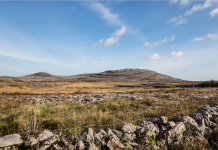Written by: Neha Pathak, MD
Here’s a prescription for improving the health of U.S. residents – and at the same time, helping to protect the climate.
It’s called lifestyle medicine.
As a physician practicing in this growing field, I help my patients address common chronic conditions, like heart disease, diabetes, and lung problems, by focusing on six major changes to their lifestyles. Beyond a focus on medicines, I prescribe strategies like eating whole, plant-based foods, getting physical activity, avoiding toxic substances, improving sleep, connecting with others, and managing stress – often through nature-based therapies.
Catherine Collings, MD, a cardiologist and president of the American College of Lifestyle Medicine, where I serve on the board of directors, points to the broad and growing consensus and updates in medical guidelines that demonstrate the power of these simple interventions to prevent, manage, and sometimes reverse many chronic diseases, like high blood pressure, heart disease, diabetes, and even certain cancers.
The beauty of these approaches is that they’re often good for the planet, too. And the field of lifestyle medicine is gaining importance at a critical moment.
Climate change is a growing danger to health
For the 60 percent of American adults with at least one chronic condition, climate change may intensify the threats to their health.
My patients with chronic conditions are among those most at risk from climate change-related heat waves, extreme weather events, and worsened air quality. Heat puts an immense strain on those with heart conditions and diabetes. Some long-term medicines can interfere with the body’s ability to cool down, increasing patients’ risk of heat-related illnesses. And climate-related weather disasters can interfere with medical follow-ups.
Even though health professionals train to address chronic disease prevention and management, many of us are still not equipped to talk about the overlapping health risks of the climate crisis in the exam room.
“When patients come to see their physicians, they are first and foremost invested in their own health, and I do believe that the responsibility of the physician is to first tune in to that patient as an individual, into their concerns,” Collings says.
But evidence from the Lancet Countdown on health and climate change report and other recent studies show that many lifestyle prescriptions are not just powerful in the fight against chronic disease but are also part of robust climate “solutions.”
A diet for a heating planet
Physician Jonathan Patz, director of the Global Health Institute at the University of Wisconsin – Madison, points out that a shift toward plant-based diets has major health benefits and the potential to slow global warming. Estimates of the global food system’s contributions to heat-trapping emissions vary, but a recent Food and Agriculture Organization puts it at a whopping 31 percent. From deforestation, fertilizer use, processing, packaging and transport, the emissions stack up and so does the pollution of air, water, and soil.
The pollution produced by raising animals for food is generally much higher than those produced by growing plant-based food. Beef is at the highest end of the spectrum: Producing just one kilogram of beef leads to about 60 kilograms of greenhouse gas emissions. In contrast, growing one kilogram of many fruits, vegetables, and nuts results in only about one kilogram of greenhouse gases.
The health benefits of a plant-predominant diet are equally staggering. Poor diets – those low in whole grains, vegetables, fruits, nuts, and high in red meat, salt, and processed foods – kill 11 million people worldwide every year. Almost 50 percent of Americans have poor-quality diets and 90 percent do not meet daily recommendations for fruit or vegetable intake.
For those interested in shifting toward a plant-predominant diet, Patz recommends a planetary health diet developed by the EAT-Lancet commission, which emphasizes whole grains, fruits, vegetables, nuts and legumes. This prescription can save millions of lives and help preserve the health of the planet.
Avoid the car, get your body moving
Active transport, meaning walking or bicycling where possible, is another lifestyle medicine prescription that Patz describes as “multi-solving.” Sedentary lifestyles kill over 4 million people globally, and about 25 percent of Americans are classified as physically inactive. At the same time, about 29 percent of heat-trapping greenhouse gas emissions come from the U.S. transportation sector.
As a result, biking or walking to do errands rather than driving a car can improve your health and reduce emissions, too.
“We found that if you could take short car trips off the road,” Patz says, “you have air quality benefits but you’d have enormous exercise benefits as well. … We’re talking about 1,300 lives saved every year from reduced air pollution and increased physical fitness.”
Unfortunately, many of my patients suffer from “active transport inequities.” In other words, their neighborhoods were not designed with health in mind. Dangerous roadways, lack of sidewalks, and other threats limit safe outdoor physical activity. As the link between increased walkability and lower rates of chronic conditions like diabetes and obesity strengthens, many health professionals are advocating for “community prescriptions” for walkable neighborhoods to help reduce this inequity.
Beware of toxic substances
I often advise patients to avoid tobacco, alcohol, and illegal drugs.
But health professionals don’t typically emphasize limiting exposure to air or water pollution. For some lifestyle medicine providers, this oversight is a critical gap in preventive care. Just like smoking cigarettes can lead to heart and lung damage, so can air pollution.
By some estimates, air pollution, caused in part by the burning of fossil fuels, is responsible for over 4 million deaths annually, with some estimates placing the number of deaths as high as 8 million. It also increases the burden of chronic disease from conditions like dementia, heart, and lung disease.
Collings, the American College of Lifestyle Medicine president, says that it is hard for health professionals to talk about pollution exposure in the exam room because most patients can’t control the toxic substances in their environment.
But providers can encourage patients to make a habit of monitoring outdoor air quality by visiting sites such as AirNow.gov. On days when air quality is poor, you can limit pollution exposure by wearing N95 masks or avoiding outdoor activity.
Ultimately, health advocates hope that a prescription to improve individual health may also drive action to limit pollution for entire communities. Knowing that air pollution can damage the heart, lungs, and brain may help communities come together to prevent the expansion of polluting traffic or other industries that could worsen local air quality – especially in marginalized communities that already bear a disproportionate burden of pollution exposure.
Heat, disasters are threats to restorative sleep
The connection between poor quality sleep and many chronic mental and physical health conditions continues to strengthen. At the same time, climate change-related impacts pose a hazard to both sleep quantity and quality. For example, displacement resulting from climate-related weather disasters threaten healthy sleep patterns. So do long stretches of high temperatures, particularly in neighborhoods that have lost protective tree canopies.
One specific intervention lifestyle medicine providers recommend is to preserve tree canopies, particularly in urban areas. Not only do trees soak up greenhouse gasses, they help reduce local temperatures and noise pollution, facilitating better sleep.
Manage stress, stay connected
Climate-related threats to mental health are increasingly recognized by patients and health professionals. These threats include eco-anxiety, post-traumatic stress disorder – or PTSD – related to climate disasters, and mental-health stress linked to higher temperatures. In the long-term, chronic stress not only affects health but makes it harder for people to make healthy lifestyle choices.
Here again is a “multi-solving” opportunity. Lifestyle medicine practitioners encourage the use of green space, nature, and parks for stress management and mental and physical health. These uses encourage the preservation of spaces that also remove greenhouse gasses from the atmosphere.
Beyond the individual health benefits, shared green spaces and parks can enhance social connection and happiness within communities. Though social connection has not traditionally been thought of as medicine, the health effects of isolation have helped doctors see the importance of community ties for health.
With the increasing threats posed by climate disruption, lifestyle medicine health professionals are recognizing that prescriptions for social connection are even more critical. By helping patients identify sources of community support, we may be able to limit disruptions to health and healthcare access in the lead up and aftermath of extreme weather events, because isolated patients tend to have a harder time getting care and services after disasters. Social connection can also protect mental health in the wake of climate disasters: Researchers recently found that higher levels of social support helped people cope and reduced the risk for mental health conditions after Hurricane Maria devastated Puerto Rico.
Inspiring health professionals
Collings says that with every prescription for healthy, plant-based nutrition, physical activity, nature-based therapy, and social connection, health professionals are charting a path toward both individual and climate health.
She says she hopes her organization’s work will inspire health professionals to protect patients from both individual and planetary health threats.
“We know health practitioners are so much more effective when they bring their own passion into the appointment,” she says. “Prescribing these interventions help actualize their passions fully and know that through their health care encounters, they’re actually changing the lives of people and the planet.”
Header Image Credit: Marco Verch/Flickr (CC BY 2.0)
This article originally appeared on Yale Climate Connections







